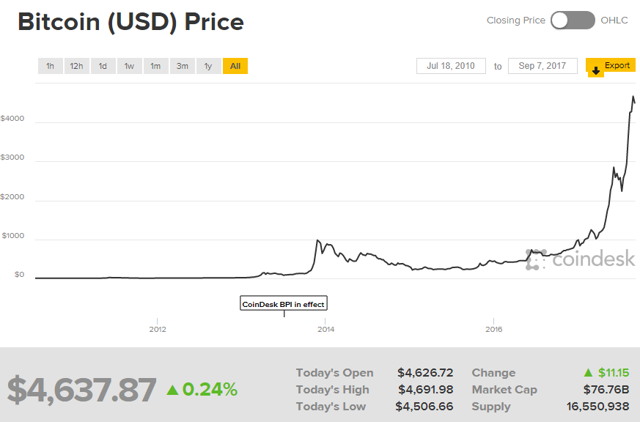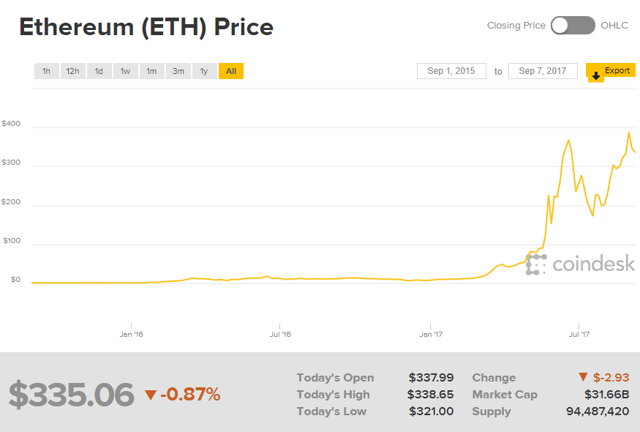I get myself into trouble with many readers when I mention the “B-word” when referring to the move in the cryptocurrencies in 2017. Those devotees of the new asset class that includes Bitcoin and Ethereum are happy to accept the term “bull market” when describing the price action in these assets. However, when I have used the word bubble, the hair stands up on the back of their necks, and I get lots of nasty and passionate comments. On the other side of the coin, those who reject the idea of the cryptocurrency world have been providing scores of reasons why the market in the digital currencies will disappear in a flash. However, this year that flash has been nothing short of a fire, a bullish and bublicious inferno of buying and that is a lot of Bs that will likely bother and badger or even bug almost everyone who reads this piece.
The truth is that I was a doubter in the early days of Bitcoin and other cryptocurrencies, which I wrongly looked at as economic science fiction rather than financial fact. Meanwhile, I was 100% wrong and have admitted so much in many articles over the past two years. The price appreciation in Bitcoin and Ethereum have humbled me as the two markets are moving on what I learned early in my career is the most significant reason for price appreciation. The bottom line is that there are more buyers than sellers in these markets. In 2017, buying has amounted to nothing short of a stampede to an extent seen in few markets through history.
The digital currencies experience unprecedented gains in 2017
My training is as a commodities trader, so I am accustomed to volatility. I am used to the price of a raw material doubling, tripling or quadrupling and then halving or worse over short time frames. I watched as the price of sugar traded to 2.29 cents per pound in 1985 after it traded to over 45 cents in 1980 and over 60 cents in 1974. I watched as silver rallied from under $2 per ounce to $50 and then back to under $6. Most recently, the price of cotton rallied from under 60 cents per pound in 2009 to $2.27 in 2011.
There are so many more examples of markets I have watched explode and implode over the years, too many to mention. I am not afraid nor am I intimidated by price variance; in fact, I embrace it because I believe that volatility creates a trader’s paradise. Meanwhile, I have never witnessed anything like the price volatility in the world of digital currencies. Bitcoin is only a baby at seven years old. However, this baby has appreciated from 6 cents to almost $5000 over the span of its lifetime.  Source: Bitcoin Price Index – Real-time Bitcoin Price Charts
Source: Bitcoin Price Index – Real-time Bitcoin Price Charts
The chart shows the moon shot that has been the price history for Bitcoin. At $4630, a $1000 investment in 2010 is worth over $77 million today. I cannot think of one other investment vehicle in my lifetime that was available on the open market that offered the kind of reward that Bitcoin has. This year alone, the cryptocurrency has more than quadrupled in value appreciating from $956 at the end of 2016.  Source: Ethereum Price – CoinDesk
Source: Ethereum Price – CoinDesk
Ethereum is even younger than Bitcoin, as it began trading in September 2016 at a price of $1.20. Today, just one year later, it has appreciated by over 279 fold and is trading at over $335. A $1000 investment in Ethereum last year at this time would be worth more than a quarter of a million dollars today.
Some call it a bubble, while others say it is just the beginning for these digital assets. I say “wow” — I have never seen anything quite like the price action in these vehicles.
Digital currencies in a digital world
We live in a digital world. I just moved into a new house, and my iPhone controls almost everything. I can open the doors, set the alarm, turn the lights on and off, and control the heat and air-conditioning through my digital device. I pay my bills via my computer or iPhone and never need to carry cash around. Email has replaced the need for stamps, and my correspondence arrives at its destination in the blink of an eye. The phone I carry in my pocket is a computer, camera, recording device, compass, and much more.
The world has changed dramatically over the course of my lifetime, and I guess digital currencies like Bitcoin and Ethereum are just a natural extension of today’s world. The digital world has simplified daily tasks. However, many of us who have accepted and embraced the current times and innovations wonder what could happen if there is a significant failure.
An electronic failure could be the biggest risk for the cryptocurrencies
As I read about the current conflict with North Korea, I learned all about the risks of EMP or electromagnetic pulse as a strategic weapon. Whether it is North Korea, Iran, or a terrorist attack, an EMP would fry the power grid of the United States. By burning out a portion of the three hundred or so high voltage transformers that link the United States together as an industrial age economy everything would stop functioning. We could not use our phones, computers, and the necessities of life would disappear in a flash. While digital currencies could vanish in a blink of an eye, legal tender like dollars, euros, yen, and other exchange instruments would likely become worthless paper. Most importantly, many people would perish and those who survived would be thrust back in time to a world that existed centuries ago.
The U.S. is one of, if not the most advanced nation on earth. However, our power grid and infrastructure are old-school and in need of an upgrade to meet the risks of modern day technology and warfare. Aside from electronic failure, the massive leap in value in cryptocurrencies surely makes them a target for hackers and others who operate in the electronic world with nefarious goals. Many people around the world are coming around to understanding and accepting currencies like Bitcoin, Ethereum, and other digital currency instruments.
The fact that they are global and fly below the radar of governments and regulators makes them the perfect means of exchange for drug and arms dealers, as well as other criminal enterprises and activities. It is wonderful that one can buy a cup of coffee with a Bitcoin debit card in cities in Europe or Japan these days, but that is not the essence of why the market has grown to a market capitalization of over $100 billion between the two digital currencies.
A commentary on traditional markets
The digital age comes with benefits and risks. Bitcoin and other cryptocurrencies are a rejection of central banks and governments that control the money supply. In the world of digital money, it is buying and selling alone that determines the value of the asset against other currencies around the world. The value of the digital money has been rising, but it may just be that the traditional forms of currency are declining precipitously. Economists view inflation as a major risk that eats away at the value of money.
However, the world of digital money has complicated the risk of monetary debasement, and central bankers and regulators have no control over this segment of the market. In the wake of the global financial crisis of 2008, the world’s monetary authorities dug deep into their tool boxes to avoid a depression. They injected unprecedented levels of liquidity into markets, slashing interest rates and instituting programs of quantitative easing to inhibit saving and encourage borrowing and spending. However, there are no tools when it comes to the world of digital currencies, although there are a myriad of applications aside from the world of crime.
Since these instruments can move wealth around the world with the click of a mouse, they can be employed to shelter assets from spouses, tax collectors, or unfriendly governments. Today, one of the primary goals for technological advancement is in the area of AI or artificial intelligence. Elon Musk, a modern day Thomas Edison, has said that AI presents the greatest risk for the world. Vladimir Putin has stated the country that controls AI will rule the world in coming years.
I believe the biggest argument in favor of digital currencies surrounds us on a daily basis. Technology has changed the world and banking, and currency markets have become fossils of the past. If I can heat or cool my home on the other side of the world, controlling my savings through a tool that only I can see, and control makes complete sense. The rise of Bitcoin, Ethereum, and other digital currencies are a natural extension of the world we live in today, and they are a commentary on traditional markets that will slowly become extinct. The dollar may be destined to be like the Betamax and the euro like the VCR.
Will governments embrace or reject a trend that is significant?
Governments have little choice but to accept the inevitability of digital currencies now that the cat is out of the bag. The price trend this year alone has been more than important and a harbinger of the future of all markets. Blockchain technology, the brainchild of Bitcoin, will revolutionize bookkeeping and accounting as it quickly and efficiently tracks ownership. The CFTC in the United States and other regulatory agencies around the world, have validated blockchain, and they will eventually do the same for digital currencies.
The means of exchange that lives in the cyber world is the next step in the globalization of the world. Many governments are against the digital currencies because they exist in a borderless world; for them, the issue is control. Globalization or nationalism has become a hot-button issue in political contests around the free world. Brexit was a rejection of globalism. The rejection of immigration policies and slogans like “America First” during the U.S. presidential contest are anti-global rhetoric that is an effective message for those who fear a new and different world order.
The problem facing the world is that we exist in a world where various political systems, ideologies, and belief systems coexist because of borders. That symbiosis is easy when there are borders separating people, but when the walls come down, the differences become apparent. In my opinion, governments will attempt to shut down the digital currency world sooner rather than later as Bitcoin and other digital means of exchange threaten their very existence. China has already moved in this direction, and so has Russia. The centrally planned governments have no patience for individual will.
However, even in democracies in the U.S. and Europe, full acceptance of the digital currency world works counter to revenue collection and economic control, free will only goes so far in modern democracy. The latest news that the president and Senate Minority Leader Chuck Schumer seem to be negotiating to get rid of the debt ceiling could mean that the government has no intention of reducing the level of national debt, and that provides justification that government officials prefer to spend at their discretion with the printing press as the only instrument to bail them out. Out of control government debt is another reason why digital currency makes sense, but government will do everything to stand in the way of success of the pan-global means of exchange.
Meanwhile, the ascent of these instruments is not only shocking from a value perspective; it is a journey that transcends money and wealth and a trend that started with the technological age. The destination of this trip is not clear, but is likely one that will create great concern and resistance by the status quo governments. After spending lots of time thinking about the appreciation in Bitcoin and Ethereum this year, the one thing I am sure of is that they are not bubble markets rather they are making a statement. Cryptocurrency-mania may look like a bubble if the governments of the world get together and shut them down which is in their self-interest and would make them worth zero in a flash. The record breaking ascent of value in digital currencies is a byproduct of the age of technology that has made the world a smaller place with each new product that hits the market. Meanwhile, those cryptocurrency bulls continue to charge higher and nothing breeds acceptance like a good old-fashioned bull market that today is combining old world greed with the new order.
To profit from commodities, you have to stay ahead of the trade. As a veteran commodities market watcher, I’m uniquely qualified to help you do that. My Marketplace service, the Hecht Commodity Report, offers a comprehensive weekly outlook on over 30 individual commodities markets, including U.S. futures. One of the most detailed commodities reports available, The Hecht Commodity Report provides weekly up, down or neutral calls on each market and highlights technical and fundamental trends. I also make timely recommendations for risk positions in ETF and ETN markets and commodity equities and related options. The Hecht Commodity Report is a must-read if you want to profit in commodities, so subscribe today.
Disclosure: I/we have no positions in any stocks mentioned, and no plans to initiate any positions within the next 72 hours.
I wrote this article myself, and it expresses my own opinions. I am not receiving compensation for it (other than from Seeking Alpha). I have no business relationship with any company whose stock is mentioned in this article.
Additional disclosure: The author always has positions in commodities markets in futures, options, ETF/ETN products, and commodity equities. These long and short positions tend to change on an intraday basis.
Editor’s Note: This article covers one or more stocks trading at less than $1 per share and/or with less than a $100 million market cap. Please be aware of the risks associated with these stocks.
Our Social Networks: Facebook Instagram Pinterest Reddit Telegram Twitter Youtube






